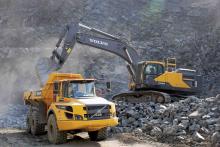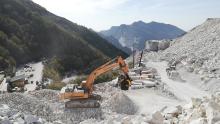Following one of its most serious recessions ever, the Italian construction machinery sector appears to be on the road to recovery. Patrick Smith reports.
The construction machinery sector in Italy in recent years has experienced one of its most serious recessions ever. But, according to recent figures from Unacea, the Italian
Unacea says this is a good performance for the Italian production of construction equipment that reached €2.6 billion in 2016, and which is forecast to see a moderate increase when the 2017 figures are finalised.
Export levels also remain high with a national range of 75% of production exported, and peaks of up to 95%.
“National industry and market continue to show signs of recovery. However, there are still several missed opportunities,” says Paolo Venturi, president of Unacea.
“For a long time, we have been asking the municipal administrations to recognise the issue of emissions in urban centres resulting from the use of obsolete construction equipment.
“Measures introduced in 2017 on the matter, which consider emissions from agriculture and domestic heating in addition to vehicular traffic, would seem to go in the right direction. But, the construction equipment sector remains excluded, still with no kind of restriction to the use of obsolete machines, and that would be a great contribution to improve the air quality.”
Such figures are good news for Italy, and they are backed by
The January 2018 Samoter Outlook, a monthly report monitoring foreign trade, shows that the trade balance between imports and exports of all construction equipment for January-October 2017 was a positive €1.522 billion compared to €1.4 billion in the same period in 2016.
Among these statistics, the export of aggregate preparation machinery showed a significant increase but imports were down.
“We saw a positive trend for construction equipment in 2017 in quarrying, for example, marble or basalt, as well as in the industrial and recycling sectors,” says Stefano Tacchinardi, managing director of Volvo CE Italia.
“The Italian construction equipment market grew by about 20% in 2017, mostly due to the fiscal incentives (or tax incentives) called iper-ammortamento and super-ammortamento, which translated into English are hyper and super depreciation,” he says.
“These fiscal incentives give the possibility to depreciate at 140% (hyper depreciation) and 250% (super depreciation) new capital goods that Italian companies buy. The aim of this measure is to incentivise Italian firms to invest more. However, this depreciation rate is applicable only to high-tech purchases: those capital goods that are part of Industry 4.0.
“We expect to see a positive trend for construction equipment in 2018 and the market will grow about 10% (thanks also to the hyper and super depreciation fiscal incentives that are extended into 2018). Quarry aggregates activities and the industrial and recycling sectors will consolidate the positive trend registered in 2017.
“The most requested equipment in 2017 has been compact excavators and GPPE excavators (medium and large platforms).”
The company covers the Italian construction market with branches and an independent sub-dealer network. In total it has four branches and three sales offices, both owned by Volvo CE Italy, and 22 independent sub-dealers. Concerning service, it covers the Italian market with about 50 workshops.
Asked how he sees 2018 in the Italian market, Stefano Tacchinardi says: “2018 will have a positive construction equipment trend and the market will grow by about 10%.”
In Italy, mining and quarrying survey results are disseminated by the National Institute for Statistics (Istat), and in its most recent post the years 2013, 2014 and preliminary estimates for 2015 are investigated.
“Considering the fragmentary context of mining and quarrying statistics in Italy, and a growing need for information at national and international level on the issue, this survey was designed by Istat and ISPRA [the Italian National Institute for Environmental Protection and Research] in 2014.
“Due to the importance of its contents, mining and quarrying extraction survey has been included in National Statistical Program. It started for the first time in 2015 with the aim to produce official statistics to strengthen a knowledge framework on mining and quarrying activities carried out at regional level, and on environmental pressures linked to the exploitation of non-renewable natural resources,” says Istat.
In Italy in 2014, the number of mining and quarrying extraction sites amounted to 5,353, a drop of 6.8% compared to 2013). Mining sites totalled 143 and quarrying sites totalled 5,210.
“Municipalities with at least one extraction site were 2,105 (equal to 26.3% of all Italian municipalities).
“In 2014 total extraction of minerals from mining and quarrying amounted to almost 185.8 million tonnes, with an overall decrease of -4.8% over the previous year. Quarrying minerals extraction was equal to 172.9 million tonnes and mining minerals extraction to 12.8 million tonnes, respectively decreasing by -3.8% and -16.3% compared to 2013.”
A recent move in the sector has seen
“With the acquisition of Cementir Italia we significantly improve our nationwide presence in Italy,” says Dr Bernd Scheifele, chairman of the managing board of HeidelbergCement.
“For Italcementi, the acquisition is a unique opportunity to grow and consolidate its position in the Italian market. We see strong recovery potential in Southern Europe and especially in Italy over the coming years. With this acquisition we are very well positioned to create value through synergies, efficient processes, and the offer of high-quality and innovative products. The acquisition is part of our strategy of disciplined growth and increasing shareholder returns.”
Another company with a presence in Italy is
“The demand for equipment remains stable and flat but the perspective is positive,” says Ángel Luis García del Val.
“We have a huge potential in Italy and we are prepared if the market wakes up. We understood that the best approach to the Italian market is through local dealers.
“The demand for equipment is being driven by the replacement of the very old machinery and small refurbishments which provide more efficiency without big investments.”
Asked what type of equipment is most in demand, he says that it is clearly the medium and small sizes in all ranges of machinery.
One of Italy’s biggest exports in terms of quarried material, is marble, and this is highlighted at the annual
Marmomacc, the leading global event for the natural stone industry, represents the entire supply chain, from raw material to semi-finished and finished products, from processing machinery and technologies to applications of stone in architecture and design.
It features many works in marble, and prior to its 2017 event, it produced figures showing that the sale of rough blocks, both semi-finished and finished marble materials, totalled €969 million (+3.3%), while machinery and technology also performed well, posting €640 million (+26.3%) in the first half of 2017.
The Italian stone industry boasts more than 3,200 companies and 33,800 employees, according to CONFINDUSTRIA MARMOMACCHINE data, and in 2016 posted production worth €3.9 billion euros, 74% of which was exported.
Indeed, at the Carrara marble quarries of Vennai Guglielmo di Fantiscritti in the Italian Alps, increasing use of modern equipment has helped improve operational efficiency, and this includes a new
The mobile equipment is used to remove contaminants, which themselves are valuable products, from non-block marble production. (See full report in Aggregates Business Europe, March-April 2018).








